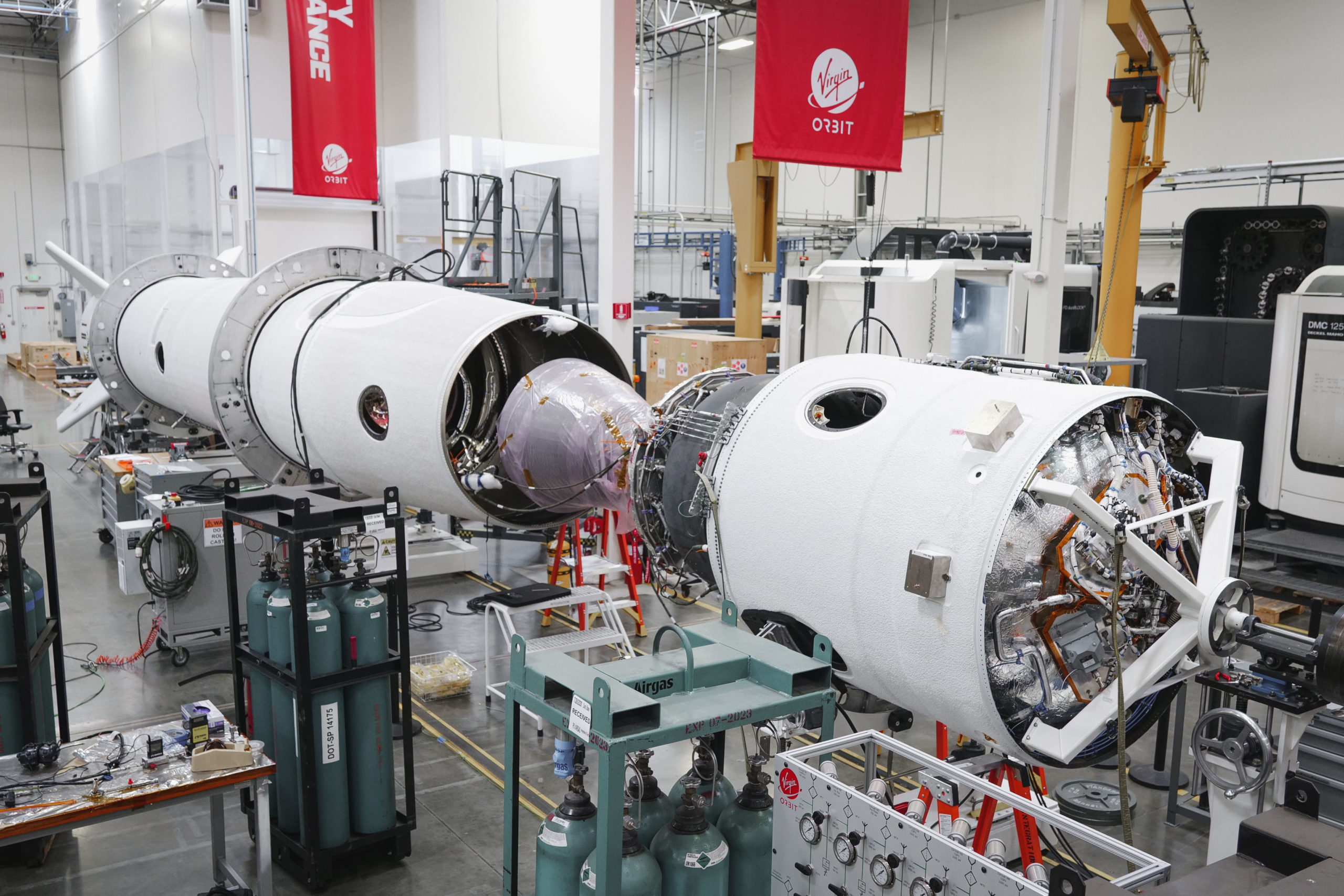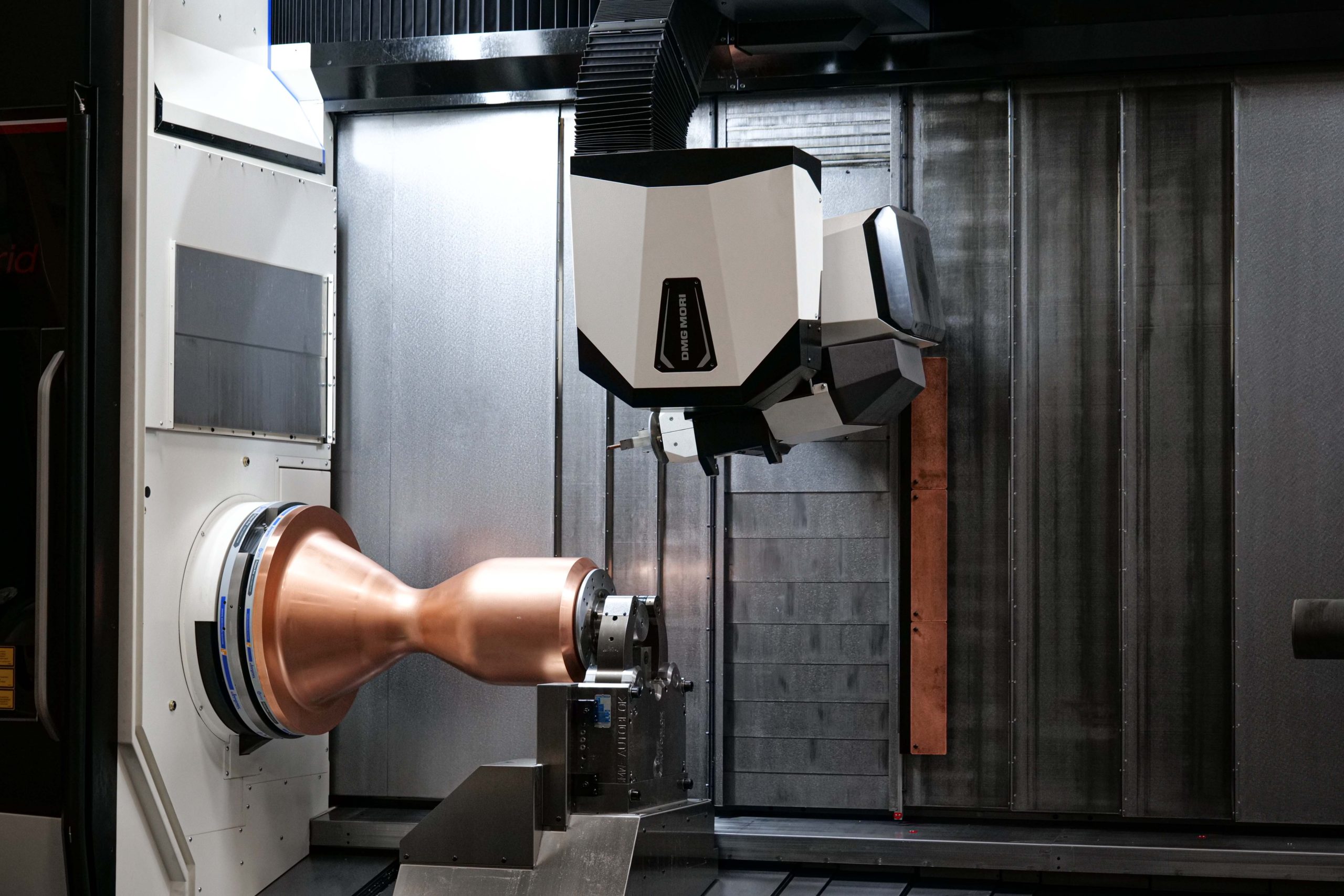Richard Branson announced plans to take Virgin Galactic spinoff company Virgin Orbit public through a merger deal with blank check firm NextGen Acquisition Corp. II (NASDAQ: NGCA). Announced on August 23, 2021, the deal values Virgin Orbit at roughly $3.2 billion and includes $483 million in capital to scale rocket manufacturing and fund growth in its space solutions business and ongoing product development initiatives, including 3D printing rocket parts.
Once the transaction is complete, the combined company’s common stock will trade on Nasdaq under the ticker symbol “VORB.” According to Virgin Orbit, the board of directors unanimously approved the proposal, which is expected to close in the last quarter of 2021.
 The rocket for Virgin Orbit’s Launch Demo 2 mission comes together for final stage mate in August 2020. Image courtesy of Virgin Orbit/Greg Robinson.
The rocket for Virgin Orbit’s Launch Demo 2 mission comes together for final stage mate in August 2020. Image courtesy of Virgin Orbit/Greg Robinson.The special purpose acquisition company (SPAC) deal with NextGen could strengthen the production of space technology that, in the words of Richard Branson, “will positively change the world.” The British mogul, who recently became a commercial astronaut during Virgin Galactic’s first sub-orbital flight, said the Virgin Orbit team had proven its ability to “create new ideas, new approaches, and new capabilities.”
Moreover, Branson’s team and the company’s transition into successful commercial launch operations is expected to intensify by 2022 since plans to ramp up launch activity and operate from several airports in the United States and Great Britain are in order.
 Cosmic Girl releases LauncherOne mid-air for the first time during a July 2019 drop test. Image courtesy of Virgin Orbit/Greg Robinson.
Cosmic Girl releases LauncherOne mid-air for the first time during a July 2019 drop test. Image courtesy of Virgin Orbit/Greg Robinson.Since its founding in 2017, Virgin Orbit has developed the world’s first air-launched, liquid-fueled launch system. The LauncherOne can take off beneath the wing of a Boeing 747 carrier plane, also known as Cosmic Girl, from anywhere worldwide. Virgin Orbit’s highly differentiated air-launch technology has rapidly moved into successful commercial operations with three launches in just thirteen months, delivering satellites for customers like the U.S. Department of Defense (DOD) and NASA. It also has what the company is describing as “a 100% success rate on revenue-generating missions.” In fact, the company has already engaged approximately $300 million in active contracts, as well as a robust pipeline of commercial and government customers around the world.
During a call with investors, Virgin Orbit CEO Dan Hart said the company made “a conscious decision” not to replicate the same ground launch approach that many competitors are using today. The two-stage rocket system is “as simple as it gets,” went on Hart, considering that each stage has a single-engine. To give some perspective on the magnitude of this advantage, Virgin Orbit’s closest competitor, Rocket Lab, has nine engines.
 Virgin Group founder Richard Branson and Virgin Orbit CEO Dan Hart during Virgin Orbit’s Tubular Bells: Part One mission on June 30, 2021. Image courtesy of Virgin Orbit.
Virgin Group founder Richard Branson and Virgin Orbit CEO Dan Hart during Virgin Orbit’s Tubular Bells: Part One mission on June 30, 2021. Image courtesy of Virgin Orbit.Propulsion is the biggest cost driver and the biggest drag on reliability for launch systems. Furthermore, Hart explained that: “The more engines you have, the more expensive the system is, and in general, the greater the part count, the lower the reliability.” On that note, the CEO went on to describe how Virgin Orbit has been leveraging advanced additive manufacturing through a partnership with machine tool developer DMG Mori to reduce engine manufacturing cycle times by tenfold compared to traditional manufacturing. The 3D printing technologies used by Virgin Orbit engineers are built into a state-of-the-art rocket manufacturing and testing facility with automated equipment. This allows the company to, for example, build tanks in days instead of months, which is usually how long it takes with conventional rocket production.
Through a total investment of more than $1 billion, the company secured a fully operational 150 thousand square foot factory which is currently developing five rockets. The advanced manufacturing facility has ensured that over 90% of the rocket manufacturing is done in-house, leading to a 60% cost reduction for its first three rockets. Hart expects to continue driving down costs.
 A NewtonThree thrust chamber is built in Virgin Orbit’s hybrid additive subtractive manufacturing machine. Image courtesy of Virgin Orbit/Greg Robinson
A NewtonThree thrust chamber is built in Virgin Orbit’s hybrid additive subtractive manufacturing machine. Image courtesy of Virgin Orbit/Greg RobinsonFor the Virgin Orbit SPAC deal, NextGen raised $383 million in cash and a $100 million fully committed private investment in public equity (PIPE) led by strategic investors including Boeing and AE Industrial Partners, existing Virgin Orbit investors, and NextGen. A blank check company targeting the industrial, technology, and healthcare sectors, NextGen is led by Co-Founders George Mattson, a board member of Virgin Galactic, Delta Air Lines, and Air France-KLM and Greg Summe, Managing Partner at Glen Capital. The company originally filed in March 2021 to raise $400 million in its IPO and previously announced a business combination with a leading manufacturer of fully electric medium to heavy commercial trucks, Xos.
Virgin Orbit follows the path of sister company and space tourism pioneer Virgin Galactic, which used a SPAC merger deal in 2019 to go public and became a trendsetter for this type of risky private venture. Up until 2019, there was an average of 21 SPAC deals per year, but since Virgin Galactic’s highly publicized move, blank check mergers skyrocketed, driving 248 transactions in 2020 and 389 in 2021. Even Virgin Orbit competitors Rocket Lab and Astra Space announced their own blank check merger deals.
Recently, however, the U.S. Securities and Exchange Commission (SEC) proposed changing some accounting rules for stock warrants that could make it more difficult for companies to go public through SPAC mergers. But just when it seemed SPAC operations were losing momentum, news of Virgin Orbit’s deal continues to fuel this alternative strategy to an IPO. In fact, Branson’s high-profile transaction will give the small satellite launch company the infusion of cash and hopes needed to expand its business.
Subscribe to Our Email Newsletter
Stay up-to-date on all the latest news from the 3D printing industry and receive information and offers from third party vendors.
You May Also Like
US Army Corps of Engineers Taps Lincoln Electric & Eaton for Largest 3D Printed US Civil Works Part
The Soo Locks sit on the US-Canadian border, enabling maritime travel between Lake Superior and Lake Huron, from which ships can reach the rest of the Great Lakes. Crafts carrying...
Construction 3D Printing CEO Reflects on Being Female in Construction
Natalie Wadley, CEO of ChangeMaker3D, could hear the words of her daughter sitting next to her resounding in her head. “Mum, MUM, you’ve won!” Wadley had just won the prestigious...
Blue Laser-powered M600 3D Printer Launched by Meltio
Founded in 2019 as a joint venture between Additec and Sicnova, metal 3D printer OEM Meltio develops and manufactures high-performance and easy-to-use metal 3D printing solutions that use its patented wire-laser metal...
3D Printed Storage Tanks Cut Material Costs by 25%
In a previous article, “Concrete Dreams: Let’s Print Money, Not Houses,” we discussed how the spotlight on 3D printing homes might be misplaced. Bollards, pedestrian bridges, and concrete tanks could...





























